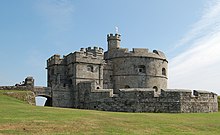Device Forts

The Device Forts, also known as Henrician Castles, are a series of artillery fortifications built to defend the southern coast of England by Henry VIII. After the King's divorce of Catherine of Aragon England was left politically isolated, and the resulting hostile relationship with France and Spain in 1538 aroused fears of invasion.[1] This threat stimulated the beginning of the first phase of the largest defence programme since Saxon times. This first phase was known as the 1539 device programme which was followed after renewed threats from the French by a second programme, the 1544 device programme. Henry’s coastal defences ranged from earthen bulwarks to small blockhouses and artillery towers to state-of-the-art Italianate-style fortifications. Henry took a personal interest in the military engineering techniques of the time, and approved and amended the designs himself. Although they were built to defend England during Henry’s reign, many of them were used in the English Civil War and were refortified at various times during the Napoleonic wars, First and Second World Wars.
1544 Device programme

This was begun after renewed threat from the French in the 1540s and concentrated on the vulnerable area around the Solent estuary and the Southampton and Portsmouth ports.
This later programme of coastal defences reflect new developments in fortifications, especially in the introduction of Italianate designs of the use of angular features. The earlier curvilinear designs of castles were replaced by square keeps surrounded by angular or arrow-head shaped bastions. Good examples of these are Yarmouth Castle and Southsea Castle built around 1545. In 1547–8, an inventory was made of crown possessions and this details the cannon and hand-arms of each fort.[2]
List of Henrician castles

Some of the key forts or castles are:
| Name | County | Date |
|---|---|---|
| Brownsea Castle | Poole Harbour | 1545–1547 |
| East Cowes Castle | Isle of Wight | 1539–42 |
| Sandown Castle | Isle of Wight | 1545 |
| Sharpenode Bulwark | Isle of Wight | 1545–1547 |
| St Helens Bulwark | Isle of Wight | 1539–45 |
| Cowes Castle | Isle of Wight | 1539–40 |
| Worsleys castle | Isle of Wight | 1522–5 |
| Yarmouth Castle | Isle of Wight | 1545 |
| Calshot Castle | Hampshire | 1539–40 |
| Hurst Castle | Hampshire | 1541–44 |
| Netley Castle | Hampshire | 1542–45 |
| St Andrew's Castle | Hampshire | 1543–44 |
| Southsea Castle | Hampshire | 1538–44 |
| Sandsfoot Castle | Dorset | 1541 |
| Portland Castle | Dorset | 1539–40 |
| Camber Castle | Sussex | 1513–43 |
| Deal Castle | Kent | 1539 |
| Sandgate Castle | Kent | 1539–40 |
| Sandown Castle | Kent | 1539–40 |
| Walmer Castle | Kent | 1539 |
| Gravesend Blockhouse | Kent | 1539 |
| Higham Blockhouse | Kent | 1539 |
| Milton Blockhouse | Kent | 1539 |
| East Tilbury Blockhouse | Essex | 1539–41 |
| West Tilbury Blockhouse | Essex | 1539 |
| Pendennis Castle | Cornwall | 1540–5 |
| Little Dennis Blockhouse | Cornwall | 1537-40 |
| St Mawes Castle | Cornwall | 1540–5 |
| St Catherine's Castle | Cornwall | 1538–40 |
| Devils Point Artillery Tower | Devon | 1537–39 |
Design
Military historian D. J. Cathcart King contrasts Device Forts with medieval fortifications, noting that "by medieval standards their profile is squat; their battlements, unpierced by loops, have rounded merlons and widely-splayed embrasures with sloping sills, to reduce damage by gunfire; and they are robustly built."[3] The early artillery forts are generally in the form of a central round tower surrounded by a variety of concentric elements. Short and squat, with normally 3 tiers of long-distance offensive armament and a couple of tiers of defensive armament. The bays had wide splays for easy traverse of the guns, walls were thick and curved to deflect shot, and the medieval portcullises, murderholes and drawbridges were perpetuated.
The later forts reflected new developments in fortifications, especially in the introduction of Italianate designs of the use of angular features. They had square keeps surrounded by angular or arrow-head shaped bastions, such as at Yarmouth.
References
- Notes
- Bibliography
- Colvin, H.M. et al. (1982). The history of the King's Works, volume 4 : 1485–1660 (Part 2)
- Elton, G.R. (1991). England Under the Tudors London: Routledge ISBN 978-0-415-06533-7.
- King, David James Cathcart (1988), The Castle in England and Wales: an Interpretative History, London: Croom Helm, ISBN 0-918400-08-2
- Harrington, Peter (2007). The castles of Henry VIII. Oxford: Osprey.
- Starkey, David, ed., The Inventory of Henry VIII, vol. 1, Society of Antiquaries, (1998), 105–144.
Further reading
- Donnelly, J. A. (1982), "A study of the Coastal Forts built by Henry VIII", Fort, 10: 105–126
- Morley, B. M. (1976), Henry VIII and the development of coastal defence, London: H. M. Stationery Office, ISBN 978-0-11-670777-2

